Mad Hedge Biotech and Healthcare Letter
November 30, 2023
Fiat Lux
Featured Trade:
(A SLEEPER HIT IN THE BIOPHARMA WORLD)
(PFE), (LLY), (VTRS), (BNTX), (SEGN)
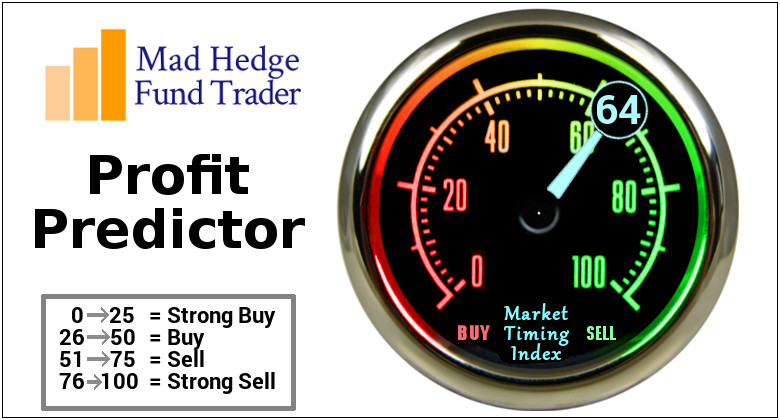
Mad Hedge Biotech and Healthcare Letter
November 30, 2023
Fiat Lux
Featured Trade:
(A SLEEPER HIT IN THE BIOPHARMA WORLD)
(PFE), (LLY), (VTRS), (BNTX), (SEGN)

Eli Lilly's (LLY) recent strides in the weight-loss treatment market have made headlines, especially with Mounjaro, their diabetes drug doubling as a weight-loss medication. The real buzz began when Zepbound, another of Lilly’s offerings, got the green light for weight management.
These developments have propelled Lilly into a potentially profitable orbit, but let's not get carried away just yet. While this company’s stock has been climbing the ladder, partly priced in with the latest news, it's worth casting a wider net.
In the world of pharmaceuticals, opportunities abound, and sometimes the best catches are not the shiniest. Enter Pfizer (PFE), a familiar name that’s been a bit under the weather, stock-wise.
Pfizer's shares have taken a 40% hit this year, a response to the waning demand for their COVID-19 vaccine and treatment.
But let's not forget that we're shifting gears to a post-pandemic era, and such shifts in demand are part of the course. Add to this the impending loss of exclusivity on some of their key products, and you've got a recipe for some financial heartburn.
In 2023, Pfizer’s performance didn’t quite match up to the market, a stark contrast to its 2021 and 2022 glory days, driven by its COVID-19 portfolio. However, looking at Pfizer through the narrow lens of recent performance alone is like judging a book by its last chapter.
Let's rewind a bit. Pfizer took some bold steps in recent years, steps that have shaped its current narrative.
The big move was shedding its consumer health and off-patent drug business, Upjohn, which led to the creation of Viatris (VTRS). The goal? To sharpen focus on innovative pharmaceuticals.
Then came the historic collaboration with BioNTech (BNTX) on a COVID-19 vaccine, marking the first U.S. authorization for an mRNA-based vaccine and bringing in substantial revenue in 2021 and 2022.
Fast forward to 2023, and Pfizer's investment fruits are beginning to ripen. This year alone, it has launched seven new products, from Litfulo for alopecia areata to the RSV vaccine Abrysvo.
Pfizer's non-COVID revenue forecast is promising, projecting up to $84 billion by 2023.
But the plot thickens. Pfizer recently announced a $43 billion acquisition of Seagen (SEGN), an oncology-focused biotech. This isn’t just a new chapter for Pfizer; it’s a whole new book, potentially leading to groundbreaking developments in cancer treatment.
With these in mind, it’s reasonable to believe that Pfizer’s current stock-market blues are but a temporary cloud.
With 83 candidates in development and a robust pipeline, partly fueled by its COVID-19 success, a rebound is on the horizon.
The dividend yield, sitting pretty at 5.5%, along with a decade-long streak of increasing payouts, adds to Pfizer's charm as a long-term investment.
So, investors should see Pfizer’s current price not as a red flag but as a golden ticket – an opportunity to get in on the ground floor before the elevator goes up. Its revenue forecast doesn’t even include its COVID-19 products, which could continue to generate significant revenue, especially during flu season.
Now, back to Eli Lilly. Yes, its revenue has seen double-digit growth recently, and it has been facing the same headwinds as Pfizer. It’s important to note, though, that its valuation makes sense in the context of its current earnings and potential growth. That makes it difficult to truly make a fair comparison at this point.
But, if we're talking opportunity, Pfizer is the one that's looking like a hidden gem. To put it simply, it's all about opportunity cost.
Pfizer, at present, is the underdog with untapped potential. Investing in Pfizer now could mean reaping substantial rewards down the line.
I’m talking about a company with a proven track record, a solid pipeline, and a knack for innovation. And for its current valuation, Pfizer is a deal that's hard to pass up.
For investors willing to play the long game, this could be the moment to seize an opportunity that could pay dividends in the future.
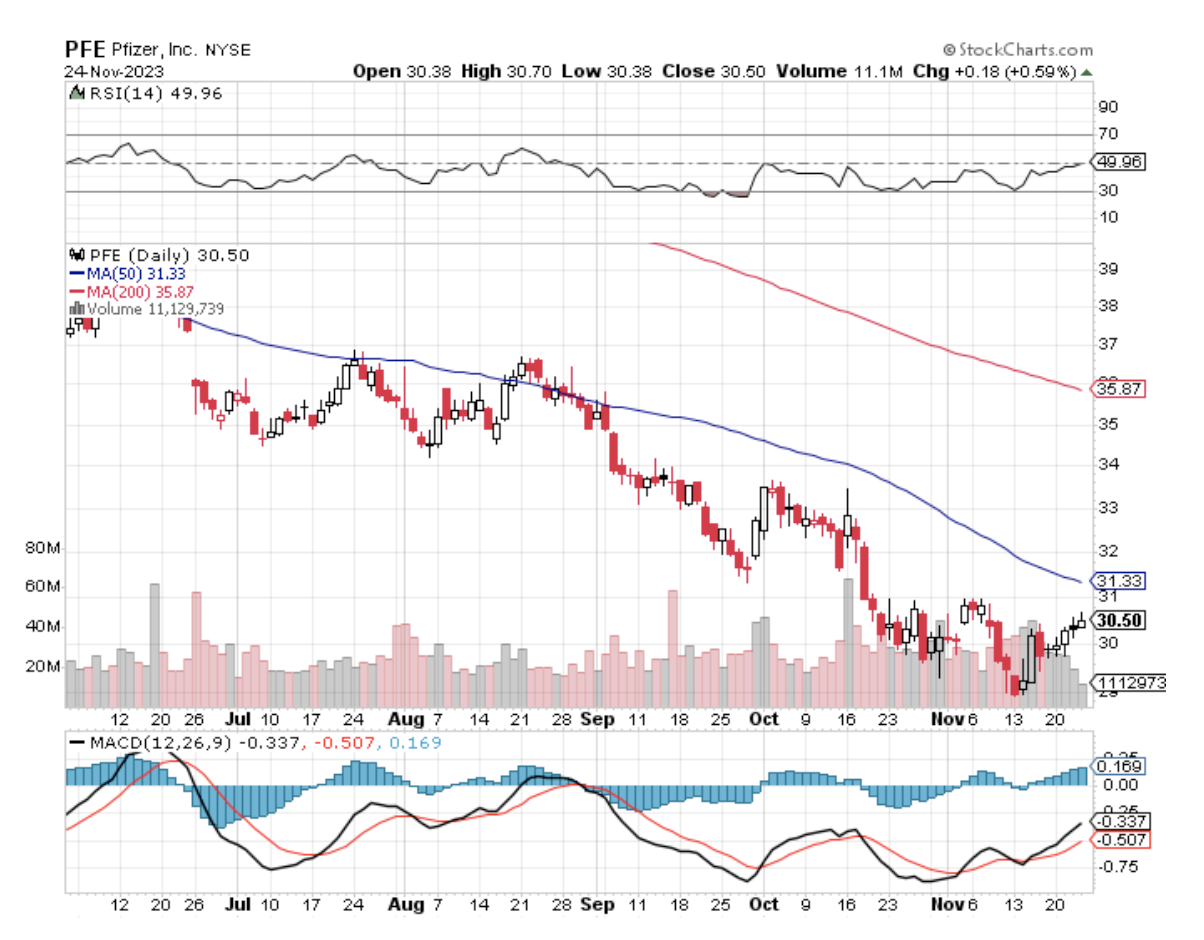
Mad Hedge Biotech and Healthcare Letter
August 9, 2022
Fiat Lux
Featured Trade:
(A REVIVED BIOTECH GAINING MOMENTUM)
(AMGN), (SEGN), (MRK), (REGN), (GILD), (CCX), (BMY)
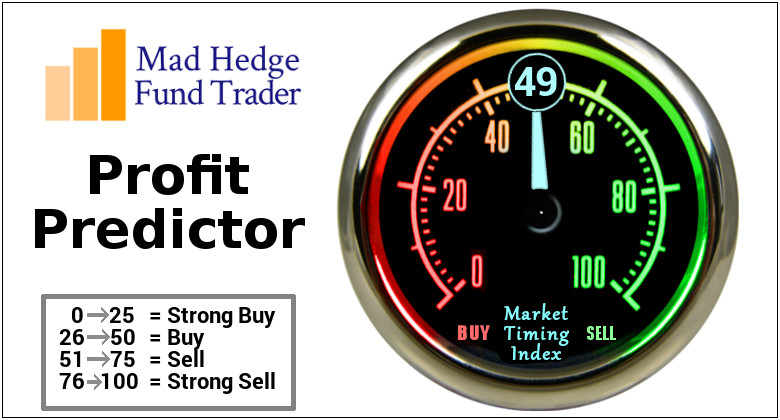
Biotechnology stocks have been rallying since mid-June, and it looks like the sector doesn’t have plans of stopping anytime soon.
The SPDR S&P Biotech ETF (XBI), which keeps track of the segment, has been up by 32.5% since the second half of 2022—a period that saw the S&P 500 rise by only 11.4%.
Nonetheless, doubts still linger in terms of how long this sector’s bull run will last. There are also questions on whether the recent shift in market sentiment indicates a substantive change or merely a momentary blip.
News about the biotech industry has been leaning towards the positive in the past months, and hopes for its recovery were bolstered by the much-discussed potential acquisition of Seagen (SEGN) by Merck (MRK).
The strong earnings reports of Regeneron (REGN) and Gilead Sciences (GILD) also added to the overall positivity of the sector.
Meanwhile, another big mover in the biotechnology world appears to be gearing up for a major move soon.
Amgen (AMGN) recently announced its plans to acquire ChemoCentryx (CCXI) for $3.7 billion.
This all-cash acquisition works out to roughly $52 per share and a whopping 115% premium to ChemoCentryx’s price.
ChemoCentryx is mostly known for its autoimmune disorder pipeline. In 2021, the company received FDA approval for Tavneos, which targets a relatively rare autoimmune condition called ANCA-associated vasculitis.
In the first quarter of 2022, Tavneos delivered $5.4 million in sales.
The announcement boosted ChemoCentryx’s shares to skyrocket by 108.4% while Amgen shares remained flat. However, this jump isn’t all too surprising.
The company getting acquired records a jump in stock price after the announcement because the acquirer typically pays a premium for the deal. It’s a strategic move since the higher the premium, the better the chances that the shareholders will approve the acquisition.
If all goes well, this acquisition is expected to be completed by the fourth quarter of 2022.
This move is a good indicator of Amgen’s response to its problem of stagnation. Over the years, this biotech giant has been seemingly left behind in churning out innovative treatments.
Pursuing a promising company like ChemoCentryx is an excellent way to diversify its pipeline and reignite growth.
The deal is especially promising in light of the company’s major setback in 2020 when the Phase 3 clinical trial for its heart failure drug fell short of delivering the promised results.
While issues with new products aren’t exactly new, particularly in the biotechnology sector, Amgen’s failure made investors skittish and led to selloffs.
However, Amgen was not deterred. After all, the setback came following decade-long progress leading up to 2020 when the company’s revenues steadily rose from $15 billion to $23 billion.
In the end, Amgen was still able to surpass its projected revenue to hit the $25 billion mark in 2020 thanks to its strategic move to acquire Otezla from Bristol Myers Squibb (BMY).
By 2021, Amgen shared that its 2020 results were up 9%. Last year, the company ignited some momentum and managed to raise its earnings from the year before to $26.2 billion.
Despite these efforts, the company still struggled with organic growth. This is perhaps why it has been aggressive in pursuing multiple revenue streams via M&A to find more ways for multiple expansions.
Part of this plan is the 2021 acquisition of Five Prime Therapeutics for $1.9 billion and Teneobio for $900 million.
Given the deals last year, investors didn’t truly expect Amgen to deliver more growth in 2022. This is possibly why the company’s shareholders were a bit surprised by the new acquisition.
However, this deal with ChemoCentryx will grant Amgen access to a slew of orally administered treatments not only for autoimmune diseases and inflammatory conditions but also for cancer.
Realistically, Amgen’s near-term outlook is not that groundbreaking. However, the overall valuation and potential of its M&A dealmaking are compelling enough to encourage investors patient enough to wait for the rewards in the long run.
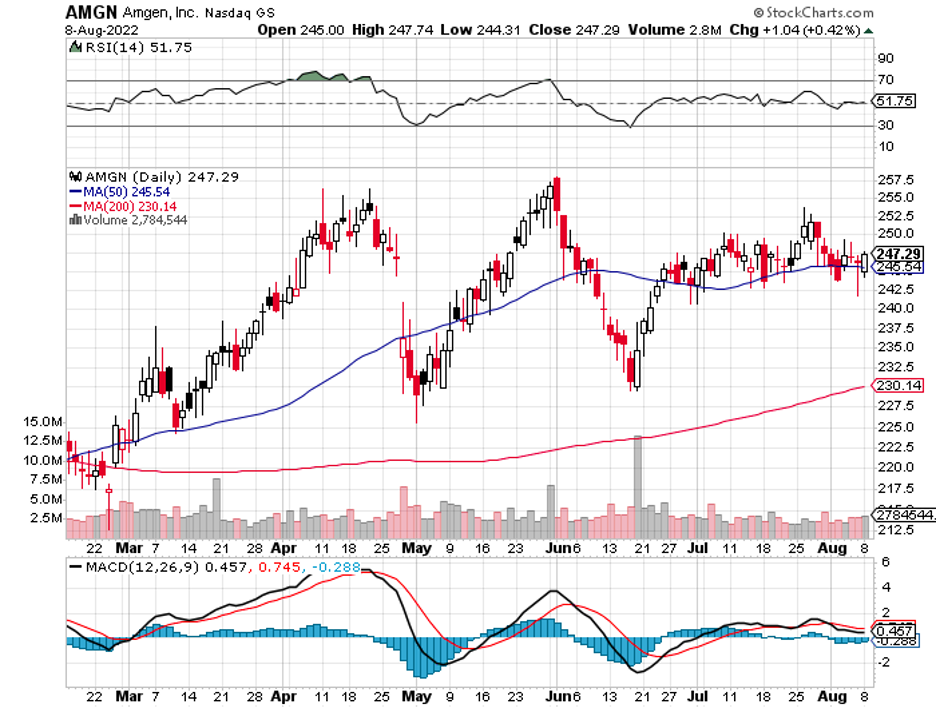
Mad Hedge Biotech and Healthcare Letter
June 21, 2022
Fiat Lux
Featured Trade:
(A POTENTIAL ONE-STOP-SHOP IN THE CANCER MARKET)
(SEGN), (MRK), (PFE), (ABBV), (JNJ)
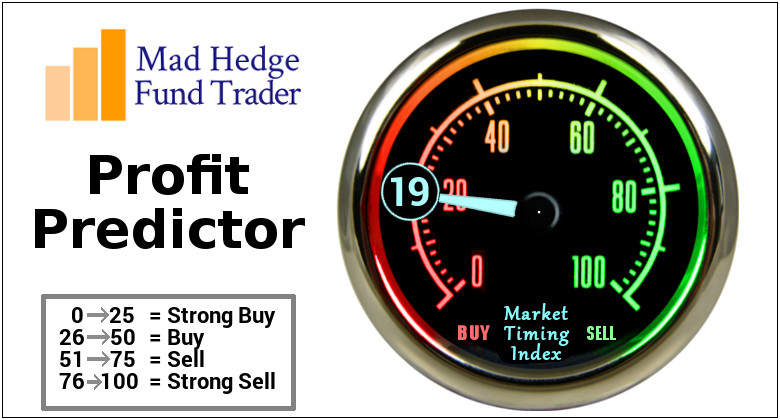
So far, there’s no clear leader in the cancer market. However, it looks like things might change soon if Merck (MRK) gets its way.
The biotechnology and healthcare sector has heard some interesting updates lately involving Merck and its frequent collaborator, Seagen (SEGN).
While Merck already has a stake in Seagen, it appears that the New Jersey biopharma wants the whole thing. There’s no need to panic buy just yet, though, since Merck still has to go through hoops to prove that its plan won’t cause any antitrust issues.
Moreover, Merck won’t be the only suitor. Several names in Big Pharma have been eyeing Seagen for quite some time, including Pfizer (PFE) and AbbVie (ABBV).
Even Japan’s Astellas Pharma, with a jaw-dropping $3.76 trillion market capitalization, is said to be interested.
If this does push through, it would be another massive deal since Seagen’s current market capitalization is at $31 billion.
Why is Seagen an attractive acquisition candidate?
This biotech currently has four cancer treatments available on the market.
It’s also reviewing a couple of candidates to determine how they react as part of a combo therapy with Merck’s blockbuster drug Keytruda.
Evidently, the potential to exclusively own the rights to compounds that could bolster the effects and expand the indications of its bestselling therapy is a significant motivation for Merck.
If the acquisition happens, Merck will undoubtedly be an incredibly formidable powerhouse in the oncology sector.
At the moment, the company already has 46 commercially approved indications in its cancer portfolio.
By 2028, Merck plans to see this number grow to over 80 oncology drugs, with Keytruda leading the charge.
Aside from its potential combination with Merck’s top-selling treatment, what’s more promising for Seagen is its actual portfolio of four molecules or its Big Four franchises.
These are Adcetris, Tukysa, Padcev, and Tivdak.
Adcetris has been hailed as the foundation of care for practically all types of lymphoma, while Padcev has been proven to be the standard of care for advanced bladder cancer.
Tukysa has been hailed as best-in-class for metastatic breast cancer, while Tivdak is the first-in-class for cervical cancer.
Holding such premier titles and indications ensures that these treatments generate highly aggressive revenue boosts, thereby guaranteeing their trajectory towards becoming blockbusters.
After all, you rarely hear of any blockbuster treatment being a second-line therapy.
In terms of sales, the Big Four managed to generate a total of $383 million in the first quarter of 2022. This indicates approximately 27% year-over-year sales growth, which bodes well for the future of Seagen’s portfolio.
Adcetris rakes in $181 million during the said period, Padcev contributed $100 million, Tukysa generated $90 million, and Tivdak recorded $11 million.
Tukysa’s growth was attributed to its penetration of the European market in February 2021, while Adcetris soared because of its expansion to include advanced Hodgkin lymphoma.
As for Tivdak, this particular product’s performance could be attributed to the fact that it was only approved last September 2021.
Among the four, however, Padcev showed the most aggressive rise in sales at a 44% increase year over year.
Its substantial growth is not only due to its superior efficacy over traditional treatments but also to its ever-increasing market penetration.
Aside from the US, it has successfully entered the UK, Japan, Canada, Israel, Switzerland, and the European Union.
Given its history and how it’s performing, Padcev is projected to become a blockbuster treatment before 2030.
Although the Big Four have delivered groundbreaking changes to the oncology sector, Seagen has been consistent in aggressively pursuing new candidates.
It currently has 17 programs in its pipeline, which target blood cancers and solid tumors.
Ultimately, Seagen’s goal is to become an all-around cancer biotech—aka the oncology sector's Johnson & Johnson (JNJ).
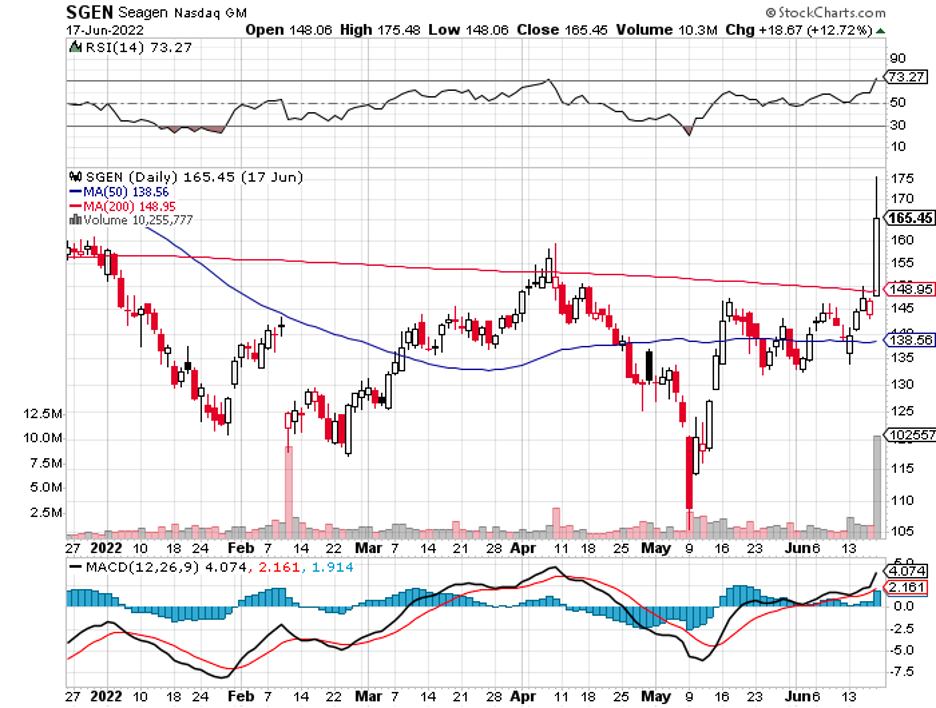
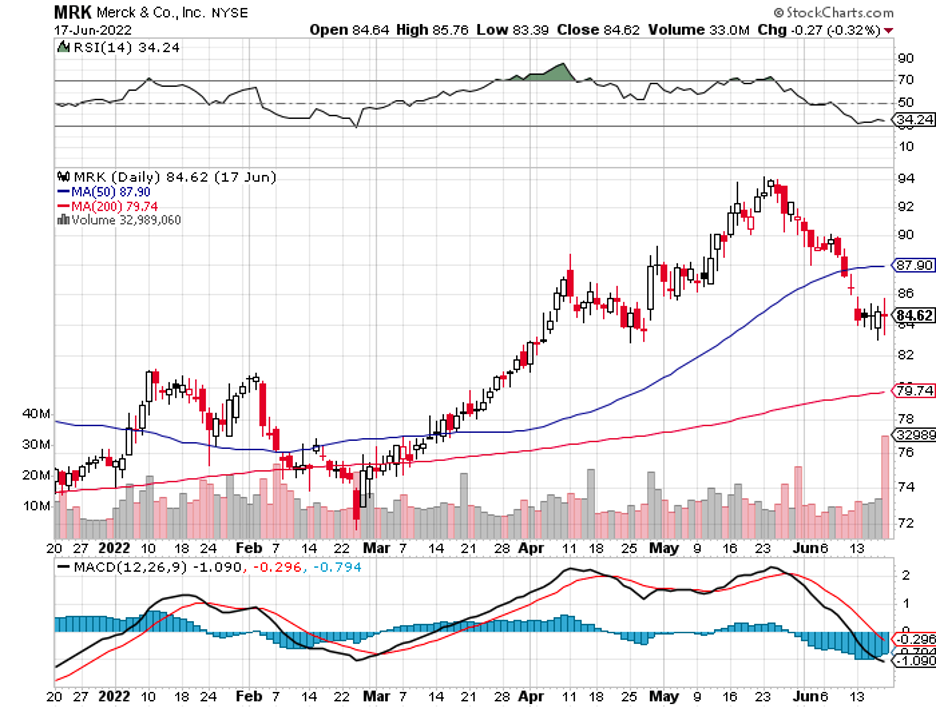
Mad Hedge Biotech & Healthcare Letter
August 31, 2021
Fiat Lux
FEATURED TRADE:
(A CANCER PIONEER FOR THE BOOKS)
(SEGN), (MRK), (BMY), (PFE), (GILD), (RHHBY), (TAK), (GMAB)
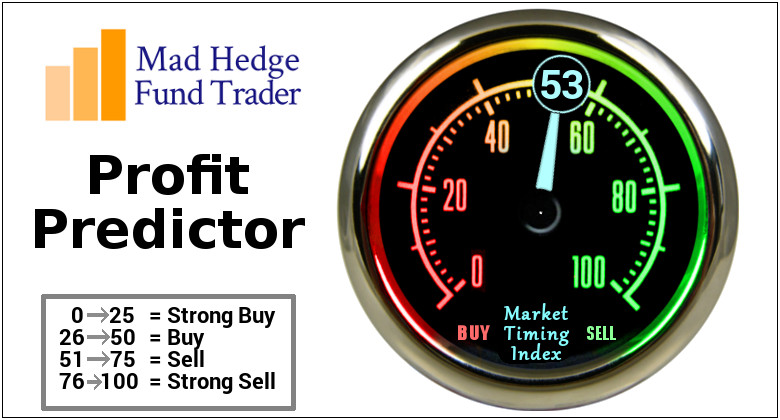
When choosing a biotechnology company to invest in, a good sign to look out for is when management continuously looks for ways to expand its technology.
This means you’re looking at a stock that’s likely to appreciate multiple folds.
Seagen (SEGN) does this in spades.
Since it was founded in 1997, Seagen (SEGN) has reached almost $30.67 billion in market capitalization.
Reviewing its growth story, I think its powerful growth strategy is one of the key elements that help the company with its advancements.
That is, Seagen is aggressively developing and expanding its different labels for the approved drugs in its portfolio while also actively discovering innovative and new treatments and molecules.
Simply put, Seagen’s growth and expansion can be likened to a tree that keeps forming new additional branches.
Over the years, the company has experienced a remarkable transformation from a single-product firm to a diversified and ever-expanding player, particularly in the oncology medication market—a strategy that paid off.
After all, the market for cancer drugs isn’t the type to stand still.
This sector is renowned for its fast-paced demands and rapid growth. If you look at how much has been done, remember that several types of cancer that seemed incurable a mere 10 years ago are now no longer considered death sentences thanks to the innovative therapies discovered.
If roughly 15 years ago, the standard cancer treatment only involved chemotherapy and surgery, the recent years have granted us access to newer technologies like targeted therapy and immunotherapy.
Lately, CAR-T therapy has been hailed as the most effective means of treating blood cancer. Meanwhile, the likes of Merck’s (MRK) Keytruda and Bristol-Myers Squibb (BMY) Opdivo have made chemotherapy and surgery more effective as well.
So, it wouldn’t be a surprise anymore if the technology in the oncology sector advances further in the years to come.
Another relatively fresh innovation is the antibody-drug conjugate (ADC) technology.
This takes and combines all the positive effects of chemotherapy and targeted therapy while simultaneously eliminating the adverse effects of chemotherapy on the patient’s body.
Unlike chemotherapy, ADCs specifically target and eliminate tumor cells and works to spare the healthy ones. Once the tumor cells are detected, a toxic drug is released to kill them.
Basically, it works like a “smart bomb” in that it annihilates only the enemies and protects the allies.
The first drug to be approved based on ADCs is Mylotarg from Pfizer (PFE), which was 20 years ago.
However, it was only in recent years that this technology finally gained traction and attracted commercial success.
So far, roughly 56 pharmaceutical companies are working on developing ADCs.
Aside from Pfizer, another pioneer in ADCs is Seagen. Unlike Pfizer, this company has chosen to continue focusing on the development of the treatment.
Other companies working on ADC technology include Immunomedics, which Gilead Sciences (GILD) acquired, and Roche (RHHBY).
However, Seagen’s work looks to be the most promising in this segment.
Its first ADC drug is Adcetris, which was approved in 2011 for Hodgkin’s lymphoma and made in cooperation with Takeda Pharmaceutical (TAK).
Its indication was later expanded to cover another white blood cell disease, Peripheral T-cell lymphoma (PTCL).
Seagen already holds roughly 45% of the market share in the Hodgkin’s lymphoma segment alone, and this is expected to rise to 50% by 2026.
In terms of projected sales in the US, Adceris is estimated to generate about $1.7 billion by 2026.
On top of that, Seagen also rakes in royalties from Adceris sales outside the US thanks to its Takeda partnership.
Riding the momentum of Adceris, Seagen expanded its ADC pipeline and later gained approval for Padcev in 2019.
This drug received the go signal to treat a fairly common disease in the oncology space: metastatic bladder cancer.
In the US, the average number of new cases of metastatic bladder cancer is 83,000. Given its market size and potential to become part of a combination therapy with the ever-popular Keytruda, Padcev is expected to generate at least $2.6 billion in sales by 2026.
Gaining more confidence in its expertise in the oncology sector, Seagen continued its expansion and gained regulatory approval for breast cancer treatment Tukysa.
Tukysa is expected to bring roughly $1 billion in annual sales in the US and European markets. This figure is projected to rise when it eventually also gains approval for colorectal cancer.
Another notable drug in Seagen’s pipeline is Tisotumab Vedotin (TV), which is a collaboration with Genmab (GMAB). TV is a cervical cancer treatment and is expected to gain approval by the end of 2021.
Shifting gears, let’s take a look at the upcoming growth of Seagen. Initially, its 2021 guidance put its annual sales at $1.28 billion for all the products.
However, Seagen has already exceeded expectations, with Adceris reporting $700 million in sales for a single quarter this year. Actually, both Adceris and Padcev are well on their way into becoming blockbusters in a year or two, thanks to their continuously expanding applications.
Overall, Seagen is an excellent long-term investment.
Aside from its work with giant biopharmaceutical companies like Merck and BMY, its current portfolio of treatments and pipeline programs present a myriad of opportunities for Seagen.
Moreover, its ability to develop powerful treatments and leverage the science of ADCs make Seagen one of the most promising oncology stocks in the market today.
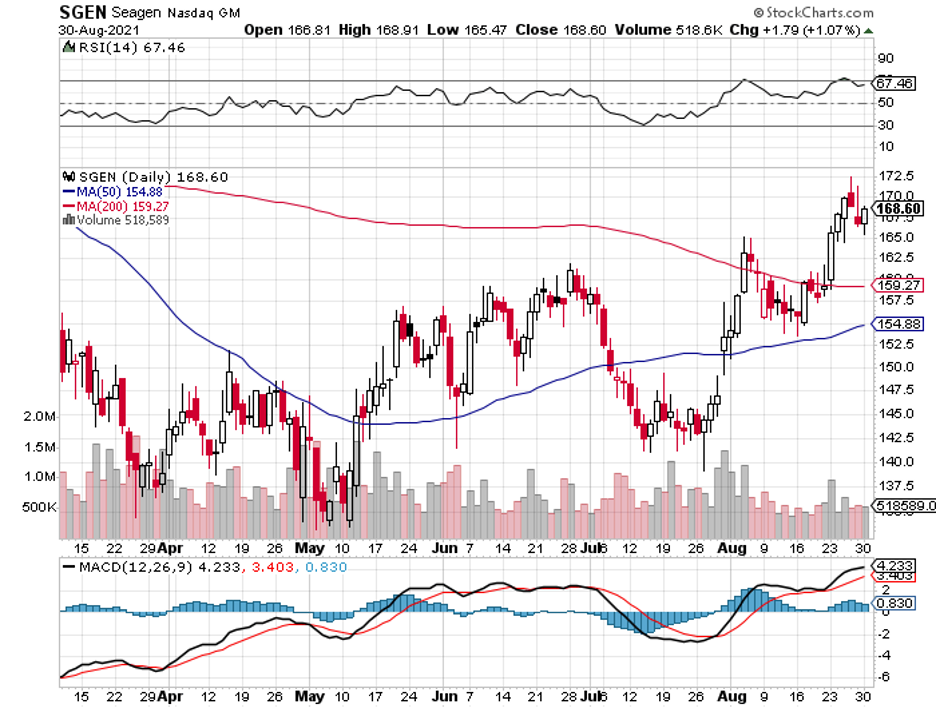
Mad Hedge Biotech & Healthcare Letter
June 23, 2020
Fiat Lux
Featured Trade:
(WHY SEATTLE GENETICS IS ON FIRE)
(SEGN), (MRK), (TAK), (GSK), (BGNE), (RHHBY), (NVS), (PFE), (IMG)

It’s not all about the Coronavirus
Though the COVID-19 pandemic has claimed the lives of over 120,000 people and is causing the suffering of almost 1.3 million patients in the United States alone, cancer and heart disease remain the leading causes of death in the country.
The American Cancer Society journal estimates that there will be around 1.8 million cancer cases this year, with 606,520 of those resulting in deaths.
Needless to say, the continuously increasing incidence of this deadly disease has prompted a number of companies in the biotechnology and healthcare sectors to invest substantially in creating and developing drugs for cancer treatment.
Buoyed by this demand, biotechnology company Seattle Genetics (SEGN) has gained 40.1% in 2020 so far primarily thanks to its cancer drugs.
In fact, Seattle Genetics welcomed 2020 with a newly approved drug called Padcev, which the company developed alongside Tokyo-based Astellas Pharma to treat the most common type of bladder cancer.
Despite the pandemic, Padcev sales have been exceeding expectations and analysts are jacking up the sales estimates for this potent bladder cancer product.
Initially pegged to rake in roughly $10 million in quarterly sales, Padcev managed to beat the estimates by four- to fivefold with $34.5 million in the first quarter of 2020.
Since then, peak sales prediction for this drug has been increased to a whopping $2 billion, with its 2020 sales target to be around $221 million.
Approximately 80,000 new bladder cancer cases are diagnosed every year in the United States. Among these patients, 90% suffer from the urothelial type -- the kind that Padcev is formulated to address.
Adding to that, Padcev’s success can also be attributed to the fact that it’s the only FDA-approved product for this particular patient set.
Riding on the momentum of Padcev’s unchallenged success in the bladder cancer field, Seattle Genetics and Astellas are now looking to expand the drug’s indication to cover an even larger patient set.
If this works out, then Padcev opens a whole new slew of possibilities to the tune of an additional $5.8 billion to its revenue.
At the moment, Padcev is also not prescribed to patients in the earlier stages of the disease - a demand that Seattle Genetics aims to address with its collaboration with Merck (MRK) via the immuno-oncology’s powerhouse drug Keytruda.
Aside from its bladder cancer drug, Seattle Genetics is also actively making a name for itself in another field.
In April 2020, Seattle Genetics received another positive news from the FDA.
The company’s breast cancer drug Tukysa, which was expected to gain approval by August this year, received the green light four months earlier instead.
Tukysa is another potential blockbuster drug for Seattle Genetics, with the product’s peak sales estimated to reach $1.2 billion by 2030.
All these are actually pretty impressive considering that Seattle Genetics was a one-product biotechnology company just a year ago.
Its single product, Hodgkin lymphoma drug Adcetris, had a specially impressive 2019 because of label expansions.
The drug posted a 32% jump in net sales to reach $627.7 million in the US and Canada. For 2020, Adcetris’ sales is expected to grow somewhere between 8% and 12%.
Apart from expanding the use of both Adcetris and Padciv, Seattle Genetics is also looking into developing new antibody treatments specifically for patients with solid tumors and lymphomas.
It currently has several candidates undergoing clinical trials, with some of these potential treatments expected to go head-to-head against active competitors in the space, including Roche (RHHBY), Novartis (NVS), Takeda Pharmaceutical (TAK), Pfizer (PFE), and Immunogen (IMG).
Prior to the approval of Padcev and Tukysa, the major growth driver that augmented Adcetris’ earnings was the company’s royalty revenue.
In the fourth quarter of 2019, the biotechnology company raked in $72.3 million in royalty revenue. This is actually triple the amount it earned in the same period in 2018.
The main source of its royalty revenue at the time is the $40 million in milestone payment it received from Takeda.
The payment was triggered by the annual net sales of Adcetris that went beyond $400 million in Takeda’s territory.
The total royalty revenue was also supplemented by a milestone payment from GlaxoSmithKline (GSK) and an upfront payment from Seattle Genetics’ work with Beijing-based company BeiGene (BGNE).
In the first quarter of 2020, royalty revenues jumped to $20 million compared to the $16 million the company earned during the same period in 2019.
Once again, this growth was attributed to Adcetris’ sales and boosted by royalties from the company’s collaboration with Roche (RHHBY) on the latter’s lymphoma drug Polivy.
Seattle Genetics has consistently grown its revenue since 2011 when its first-ever drug Adcetris received approval. With the recent additions of potential blockbusters Padcev and Tukysa, the company’s financial picture looks brighter than ever.
One of the key factors in its success is that the company addresses significant patient sets, providing its investors with the confidence that it can attract physicians and patients on board.
The Hodgkin lymphoma drug market, which Adcetris has covered, is anticipated to grow by roughly $1.24 billion from 2019 through 2023.
The urothelial cancer drug market, where Padciv is currently king, is estimated to hit $3.6 billion by 2023, with a 23% compound annual growth rate.
Tukysa addresses another patient set with high demand as well, with reports showing that the spending on HER2-positive cancer is anticipated to jump by 54% to hit $9.89 billion by 2025.
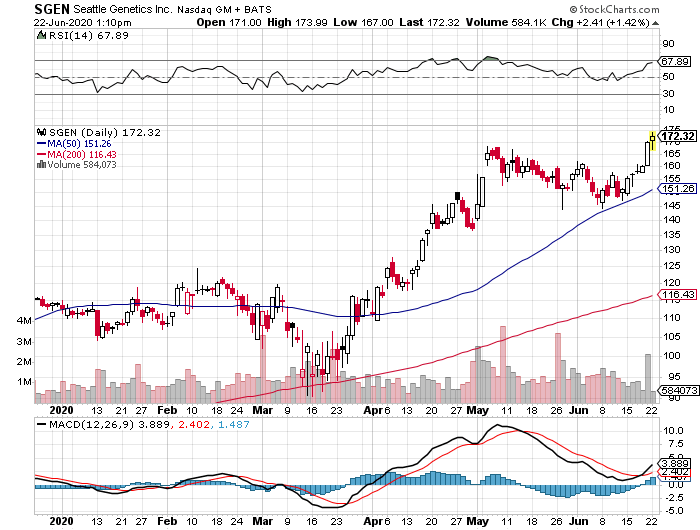
Legal Disclaimer
There is a very high degree of risk involved in trading. Past results are not indicative of future returns. MadHedgeFundTrader.com and all individuals affiliated with this site assume no responsibilities for your trading and investment results. The indicators, strategies, columns, articles and all other features are for educational purposes only and should not be construed as investment advice. Information for futures trading observations are obtained from sources believed to be reliable, but we do not warrant its completeness or accuracy, or warrant any results from the use of the information. Your use of the trading observations is entirely at your own risk and it is your sole responsibility to evaluate the accuracy, completeness and usefulness of the information. You must assess the risk of any trade with your broker and make your own independent decisions regarding any securities mentioned herein. Affiliates of MadHedgeFundTrader.com may have a position or effect transactions in the securities described herein (or options thereon) and/or otherwise employ trading strategies that may be consistent or inconsistent with the provided strategies.
This site uses cookies. By continuing to browse the site, you are agreeing to our use of cookies.
OKLearn moreWe may request cookies to be set on your device. We use cookies to let us know when you visit our websites, how you interact with us, to enrich your user experience, and to customize your relationship with our website.
Click on the different category headings to find out more. You can also change some of your preferences. Note that blocking some types of cookies may impact your experience on our websites and the services we are able to offer.
These cookies are strictly necessary to provide you with services available through our website and to use some of its features.
Because these cookies are strictly necessary to deliver the website, refuseing them will have impact how our site functions. You always can block or delete cookies by changing your browser settings and force blocking all cookies on this website. But this will always prompt you to accept/refuse cookies when revisiting our site.
We fully respect if you want to refuse cookies but to avoid asking you again and again kindly allow us to store a cookie for that. You are free to opt out any time or opt in for other cookies to get a better experience. If you refuse cookies we will remove all set cookies in our domain.
We provide you with a list of stored cookies on your computer in our domain so you can check what we stored. Due to security reasons we are not able to show or modify cookies from other domains. You can check these in your browser security settings.
These cookies collect information that is used either in aggregate form to help us understand how our website is being used or how effective our marketing campaigns are, or to help us customize our website and application for you in order to enhance your experience.
If you do not want that we track your visist to our site you can disable tracking in your browser here:
We also use different external services like Google Webfonts, Google Maps, and external Video providers. Since these providers may collect personal data like your IP address we allow you to block them here. Please be aware that this might heavily reduce the functionality and appearance of our site. Changes will take effect once you reload the page.
Google Webfont Settings:
Google Map Settings:
Vimeo and Youtube video embeds:
